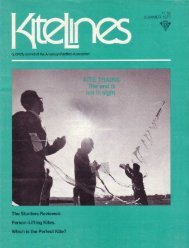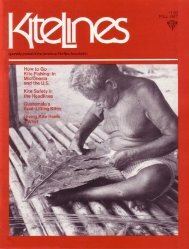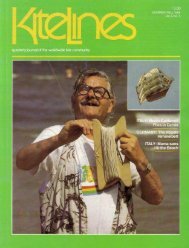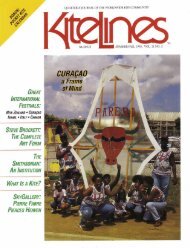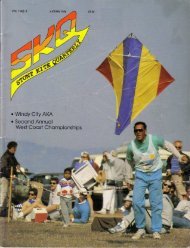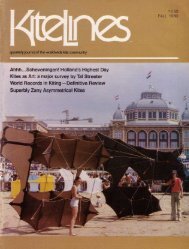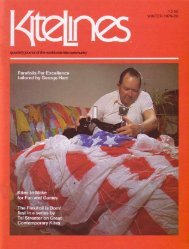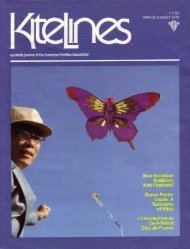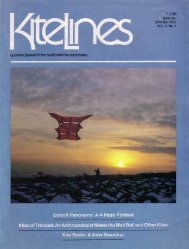Kite Lines - Vol.2 No. 4 - KiteLife
Kite Lines - Vol.2 No. 4 - KiteLife
Kite Lines - Vol.2 No. 4 - KiteLife
- No tags were found...
You also want an ePaper? Increase the reach of your titles
YUMPU automatically turns print PDFs into web optimized ePapers that Google loves.
For 23 years, Bill Trebilcock, PrincipalKeeper of the Eddystone Lighthouse, 17miles off Plymouth, England, has beenkite fishing. Within minutes of launch, hehas his fish-usually a bass, sometimes apollack, like the four pounder in the picturehere. Trebilcock believes that Eddystoneis Britain's last lighthouse strongholdof kite fishing. The other towers nowhave "chopper pads "-platforms aroundthe top for helicopters . As all good kitersknow, helicopters and kites don't mix .<strong>Kite</strong> <strong>Lines</strong> is pleased to document the system,as described by Trebilcock himself.TREBILCOCK'S RIGGING METHOD200Yearsof <strong>Kite</strong>FishingSuccessHere round the coast of England we haveseveral lighthouses which are just talltowers set on the largest rock of extensivereefs . These reef areas are by and largevery good fishing areas ; but, as the firstkeepers some 200 years ago found, mostof the time one cannot even get a line inthe water and over the rocks .Looking down from 133 feet from thegallery and seeing one's supper swimmingpast is a great spur to inventiveness . Theearly keepers went through many ideasbefore settling on a kite . Their kites andline were a bit on the rough side, but theycaught fish . Over the years the kites andgear have been improved, but basicallythe method and kite I use do not differvery much from theirs .Before I describe the set-up and method,I must point out that the problem wehave to overcome is not flying a kite upbut down . We want our kite to fly downfrom 133 feet to 20 feet above the seaand there be very stable but maneuverable .One big advantage we have, of course,is that whatever the wind we can alwayskeep it behind us and have no other buildingsor power lines to worry about .The kite I mainly use for fishing I alsouse to pass both mail and small spare partswhen it's too rough for the relief boat tocome near . The largest package I've liftedwas 25 pounds of weight hoisted off theboat's deck and carried about 400 yardsback to the lighthouse . So you can seethat kites are to us on this station notonly a means of getting our supper butfor use as a communications medium .However, back to our fishing kite . Ihave several of various sizes but all scaledup or down from the same standard kitewhich has been found to be the best inperforming what we require .The kite I use in breezes from force 3to 6 is four feet in length, a diamond shape,but with the two wings just over twothirdsof the way from tail to top . It'smade flat and two bamboo sticks about 3 /e -inch thick are lashed together to form across . Then a light line is led round theedge, and the cover, in this case light duckcanvas, is sewn to it . A bridle is fixed tothe face (opposite side to the sticks) andsewn so it is made fast through the canvasand round the sticks . This bridle startsabout four inches from the top and endsat the tail . The main line fixes to this, atwhich point a piece of line is also fixedabout two foot odd . On each wing of thekite is a ring or loop of cord which thisstray line fixes, when we set things up .It will from here be clearer if I rig up



